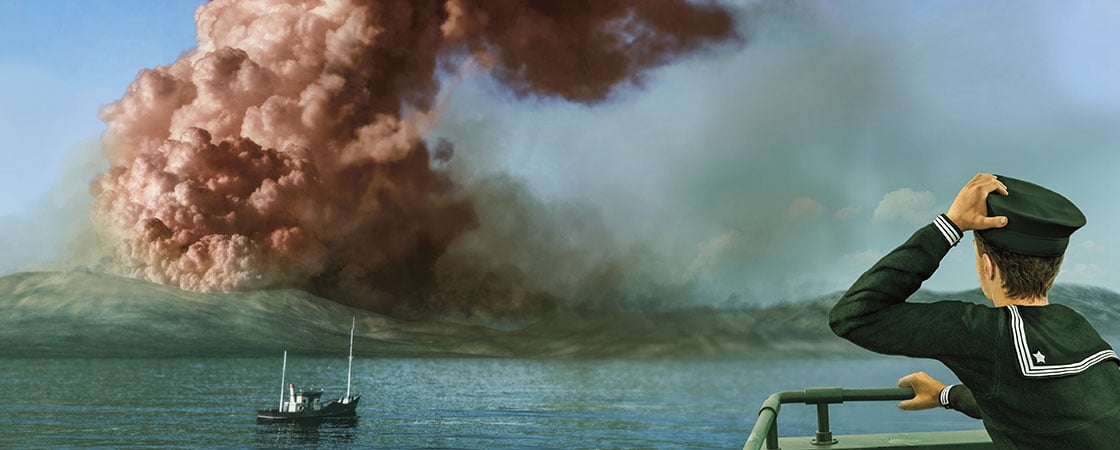Noble Driscoll, 13, woke up in a pile of rocks and crushed concrete. All he could see around him were heaps of burned brick and ash. Where was his family? Where were his friends? Noble thought he might be the last person alive.
It was the morning of December 6, 1917. Just minutes before, things had been normal in Halifax and Dartmouth. These are two cities in Nova Scotia [SKO-sha], Canada. They sit on the Atlantic Ocean. Between them is a narrow harbor.
That morning, people were busy. Moms served up bowls of oatmeal. Kids gathered their schoolbooks. Dads went to work. In Noble’s neighborhood in Halifax, horses clip-clopped down the streets, pulling wagons behind them. Factories made flour, beer, metal items, and more. At the harbor, men carried cargo onto giant ships.
Noble could see the harbor from his backyard. He loved to watch the ships pass by. Most belonged to the military. They were carrying supplies and soldiers to Europe. A terrible war—World War I—had been fought there for three years.
On one side of the war was a group of countries that included Great Britain, Canada (then part of Great Britain), France, Russia, and the United States. On the other side was a group of countries led by Germany. Millions of soldiers had died in bloody battles.
December 6, 1917, started as a normal day in Dartmouth and Halifax. These are cities in Nova Scotia [SKO-sha], Canada. But then two ships crashed into one another. One ship, called the Mont-Blanc [blonk], was carrying benzol. Benzol is a liquid like gasoline. It can blow up easily. When the ships crashed, the benzol burst into flames. The Mont-Blanc floated toward a neighborhood. Then it blew up.
The blast caused problems nearby and far away. Other ships flipped over. Trains flew off rails. Factories collapsed. Doors flew off houses. Trees snapped in two. Windows broke and glass shot through the air.
For about 10 minutes, the sky seemed to open up. Black rain fell. It was a mix of chemicals, melted metal, and broken pieces of buildings and rocks.
Noble Driscoll, 13, woke up in a pile of rocks and crushed concrete. All he could see around him were heaps of burned brick and ash. Where was his family? Where were his friends? Was he the last person alive?
It was the morning of December 6, 1917. Just minutes before, things had been normal in Halifax and Dartmouth. These are two cities in Nova Scotia [SKO-sha], Canada. They sit on the Atlantic Ocean. Between them is a narrow harbor.
That morning, people were busy. Moms served up bowls of oatmeal. Kids gathered their schoolbooks. Dads went to work. In Noble’s neighborhood in Halifax, horses clip-clopped down the streets. They pulled wagons behind them. Factories made flour, beer, metal items, and more. At the harbor, men carried cargo onto giant ships.
Noble could see the harbor from his backyard. He loved to watch the ships pass by. Most belonged to the military. They were carrying supplies and soldiers to Europe. A terrible war—World War I—had been fought there for three years.
On one side of the war was a group of countries that included Canada and the United States. On the other side was a group of countries led by Germany. Millions of soldiers had died.
Thirteen-year-old Noble Driscoll woke up in a pile of rubble. All he could see around him were heaps of burned brick and ash. Where was his family? Where were his friends? Looking around at the smoking ruins, Noble was afraid he might be the last person alive.
It was the morning of December 6, 1917. Just minutes before, it had been an ordinary day in Halifax and Dartmouth, in Nova Scotia, Canada. The two towns sit on the Atlantic Ocean and are separated by a narrow harbor.
That morning, the towns had been buzzing with activity. Soft smoke curled from chimneys. Moms served up steaming bowls of oatmeal. Children gathered their schoolbooks, and fathers pulled on their coats and headed off to work. In Noble’s neighborhood of Richmond, in northern Halifax, horse-drawn wagons clattered down the streets. Factories churned out flour, beer, metalworks, and other goods. At the harbor, sturdy-looking men carried cargo onto giant ships.
From his backyard, Noble had an amazing view of the harbor. He was fascinated by the vessels that passed by every day. Most belonged to the military and were carrying supplies and soldiers to Europe. A terrible war—World War I—had been raging there since 1914.
On one side of the fight was a big group of countries that included Great Britain, Canada (then part of Great Britain), France, Russia, and the United States. On the other side was a group of countries led by Germany. Bloody battles had killed millions of soldiers.

